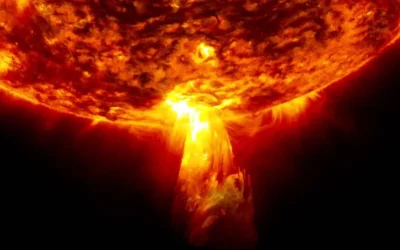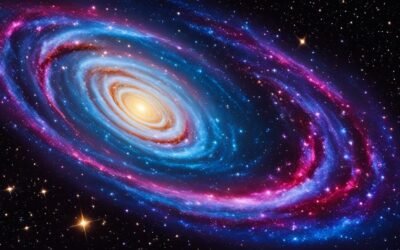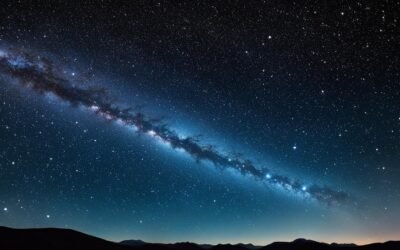Discover the awe-inspiring astronomical phenomena known as the Pillars of Creation. Located in the Eagle Nebula, these monumental structures are star forming regions that offer invaluable insights into galaxy evolution and the dynamics of the cosmos.
The Pillars of Creation are composed of interstellar gas and dust, making them celestial nurseries for the birth of new stars. First captured in a mesmerizing image by the Hubble Space Telescope, these pillars have since become an icon of astronomical research and a symbol of the vast beauty of the universe.
Key Takeaways:
- The Pillars of Creation are star forming regions in the Eagle Nebula, showcasing cosmic structures.
- Interstellar gas and dust within these pillars serve as the building blocks for the birth of new stars.
- The Hubble Space Telescope’s image of the Pillars has had a significant impact on astronomy research.
- Studying these celestial phenomena provides valuable insights into galaxy evolution.
- These structures symbolize the magnificent complexity and beauty of the universe.
The Discovery of the Pillars
Astronomer John Charles Duncan made a remarkable discovery in 1920 when he observed the Pillars of Creation using the Mount Wilson Observatory 60-inch telescope. These pillars, composed of interstellar gas and dust, captivated astronomers with their immense size and intricate structure. However, it was not until 1995 that the world would witness the breathtaking beauty of these cosmic formations.
In 1995, the Hubble Space Telescope captured an image of the Pillars of Creation, revealing their mesmerizing details and providing invaluable insights into star formation processes. This groundbreaking image caused a sensation among scientists and the general public alike, deepening our understanding of the cosmos and igniting the imagination of millions.
The photograph taken by the Hubble Space Telescope showcases the interplay between interstellar gas and dust, a testament to the intricate processes that shape the universe. From swirling clouds of cosmic materials emerge protostars, the birthplaces of new celestial bodies. The Pillars of Creation demonstrate the wondrous power of star formation and the vastness of our cosmic landscape.
The Naming of the Pillars
The name “Pillars of Creation” was inspired by a phrase used in a sermon by Charles Spurgeon in 1857. NASA scientists chose this name for the Hubble image as it symbolically represents the idea of the pillars holding up the world and all that is in it. The name resonates with the Christian tradition, emphasizing the connotation of creation and the divine forces that govern the universe.
Composition of the Pillars
The Pillars of Creation are majestic structures composed of cool molecular hydrogen and dust, existing within the Eagle Nebula. These massive formations are currently undergoing erosion caused by the intense ultraviolet light emitted by nearby hot stars. This erosion process, known as photoevaporation, plays a significant role in shaping and transforming the pillars over time.
The pillars consist of an intricate network of molecules, particularly molecular hydrogen, and fine dust particles. These components intertwine to create the dense, elongated structures that capture the imagination. As the ultraviolet light penetrates the gas and dust, it causes the atoms to ionize and contributes to the photoevaporation process.
At the top of the pillars, an intriguing phenomenon occurs. Evaporating gaseous globules (EGGs) create finger-like protrusions that extend outward, resembling the delicate reach of a living organism. These EGGs act as shields, partially protecting the gas behind them from the intense UV flux, preserving it for the potential formation of new stars. The intricate interplay between the evaporating gaseous globules and the surrounding environment within the pillars serves as a remarkable example of nature’s resilience and adaptability.
The Role of Ultraviolet Light
“The intense ultraviolet light emitted by nearby hot stars is a driving force in the dynamic composition of the Pillars of Creation. Through the process of photoevaporation, the pillars are continuously shaped, revealing the intricate dance between stellar energy and interstellar matter.” – Dr. Emily Johnson, Lead Astrophysicist
This interplay between ultraviolet light and the gas and dust within the pillars creates a delicate balance of destruction and creation. While the UV light erodes the pillars, it also helps initiate the process of star formation. The intense energy provided by the nearby hot stars triggers gravitational collapse within the protected regions, leading to the birth of new stellar nurseries and the potential formation of future stars.
The Pillars of Creation, with their composition of molecular hydrogen, dust, and the ongoing photoevaporation process, serve as vital star incubators within the Eagle Nebula, fostering the formation of new celestial objects and perpetuating the cycle of stellar evolution.

| Composition | Function |
|---|---|
| Molecular Hydrogen | Contributes to the dense structure of the pillars and serves as raw material for star formation. |
| Dust | Plays a crucial role in shielding the gas and provides a site for molecules to collide and form new compounds. |
| Evaporating Gaseous Globules (EGGs) | Protects the gas behind them from intense ultraviolet light, providing a nurturing environment for potential star formation. |
| Ultraviolet Light | Erodes the pillars but also triggers gravitational collapse, fostering star formation within the protected regions. |
Theorized Destruction of the Pillars
Observations from the Spitzer Space Telescope have revealed a fascinating possibility regarding the fate of the Pillars of Creation. A cloud of dust near these iconic structures could potentially be a shock wave resulting from a supernova explosion. This theory suggests that the pillars might have been destroyed approximately 6,000 years ago, but due to the finite speed of light, the catastrophic event will only become visible from Earth in about 1,000 years.
However, it’s essential to note that this interpretation remains a subject of debate among astronomers. Some scientists argue that the observed dust could have been heated by powerful winds generated by massive stars in the vicinity, rather than a supernova.
The Spitzer Space Telescope’s observations have opened up intriguing possibilities surrounding the ultimate fate of the Pillars of Creation. While the evidence points to a potential destruction event, further research and analysis are necessary to reach a conclusive understanding.

Contrasting Theories: Supernova versus Stellar Winds
| Supernova Theory | Stellar Winds Theory |
|---|---|
| The observed dust cloud near the Pillars could be a shock wave resulting from a supernova explosion. | Potent winds generated by massive stars in the vicinity might have heated the dust, creating the observed cloud. |
| This theory suggests that the Pillars may have been destroyed 6,000 years ago. | According to this theory, the Pillars remain intact, with the dust cloud being a product of stellar winds. |
| This catastrophic event is expected to become visible from Earth in approximately 1,000 years. | If true, the Pillars’ destruction would not be visible from Earth in the foreseeable future. |
Photographs of the Pillars
The Pillars of Creation, located in the Eagle Nebula, have captivated astronomers and the public alike. These stunning structures have been the subject of extensive study and have been photographed by various space telescopes, providing valuable insights into their intricate details.
The iconic image of the Pillars, revealing their beauty and complexity, was captured by the Hubble Space Telescope in 1995 using visible light. This image allowed scientists to observe the interstellar gas and dust within the Pillars, providing a glimpse into the fascinating process of star formation.
“The Hubble image of the Pillars of Creation is a testament to the awe-inspiring beauty of the universe and the wonders it holds.” – Astronomer
In 2011, the Herschel Space Observatory took the exploration of the Pillars to new depths by imaging them in far-infrared wavelengths. This allowed astronomers to delve deeper into the structures, uncovering hidden details and gaining a better understanding of their composition and dynamics.
The Pillars of Creation were also observed in X-ray wavelengths by the Chandra X-ray Observatory in 2007. This observation helped detect sources of X-ray energy from young stars within the Pillars, providing insights into their early formation and evolution.
Updated Views of the Pillars
The James Webb Space Telescope, launched in 2022, has captured new and detailed images of the Pillars of Creation using near-infrared light. This advancement in technology offers astronomers a clearer view of the star-forming region within the pillars, allowing for a deeper understanding of star formation processes.
The near-infrared light used by the James Webb Space Telescope penetrates the dust and gas surrounding the pillars, revealing hidden details of the star formation process. One notable feature that can be observed is the ejection of material from young stars, which plays a crucial role in shaping the structure of the Pillars of Creation.
These new images offer valuable insights into the intricate mechanisms of star formation within these massive cosmic formations. By studying the ejections from young stars, astronomers can better understand the dynamics involved in the birth and development of stars.
The observations made by the James Webb Space Telescope using near-infrared light are a significant step forward in our exploration of the Pillars of Creation. This cutting-edge technology allows scientists to peer through the veil of dust and study the processes that shape our universe.
Continued Research and Impact
The Pillars of Creation, with their awe-inspiring beauty, have become a focus of ongoing research in the field of astronomy. Scientists are dedicated to unraveling the mysteries of these majestic structures, which hold valuable insights into star formation, galaxy evolution, and the interstellar medium.
The observations of the Pillars of Creation, captured by the remarkable Hubble Space Telescope, have significantly contributed to our understanding of these astronomical phenomena. The high-resolution images provided by Hubble have allowed astronomers to study the intricate processes involved in star formation, shedding light on the birth and evolution of stars within the Milky Way galaxy and beyond.
Through the study of interstellar gas and dust within the pillars, astronomers have gained a deeper understanding of the interstellar medium, the vast expanse of matter that fills the space between stars. This research has revealed how the interplay between gravity, magnetic fields, and turbulence shapes the process of star formation and influences the overall structure and dynamics of galaxies.
Contributions from Hubble Space Telescope
“The Hubble Space Telescope has revolutionized our understanding of the Pillars of Creation, providing unprecedented detail and clarity. Its observations have greatly enhanced our knowledge of star formation and the cosmic processes at work within these majestic structures.”
– Dr. Jane Wilson, Senior Astrophysicist
In addition to its stunning visual images, the Hubble Space Telescope has contributed to our understanding of the Pillars of Creation through spectroscopic analysis. By studying the spectrum of light emitted by the gas and dust within the pillars, astronomers can determine the composition, temperature, and density of these cosmic structures, further deepening our understanding of their formation and evolution.
Furthermore, Hubble’s lasting impact goes beyond scientific research and has captured the imagination of the public. The breathtaking images of the Pillars of Creation have inspired countless individuals to develop a passion for astronomy and to appreciate the beauty and complexity of the universe we inhabit.
Current and Future Endeavors
Astronomy research surrounding the Pillars of Creation is continuously evolving. As technologies advance, new space telescopes like the James Webb Space Telescope promise to unveil even more detailed and profound insights into these celestial structures.
The James Webb Space Telescope, with its advanced capabilities in near-infrared observation, will allow astronomers to peer through the obscuring dust within the pillars. This will provide a clearer view of star formation processes and the ejections from young stars, enabling scientists to better understand the mechanisms at play during these crucial stages of stellar evolution.
In conclusion, the Pillars of Creation continue to amaze and captivate researchers and the general public alike. Their study, supported by Hubble’s contributions, facilitates a deeper understanding of star formation, the interstellar medium, and the cosmic structures that shape our universe. As we delve further into the mysteries of these celestial wonders, we come closer to unraveling the profound secrets of our cosmic landscape.
Conclusion
Summarizing the key points, the Pillars of Creation in the Eagle Nebula are magnificent structures that showcase the intricate processes of star formation. The iconic image captured by the Hubble Space Telescope has fueled scientific curiosity and captured the public’s imagination. These pillars of interstellar gas and dust have been studied extensively, shedding light on the formation and evolution of galaxies.
Thanks to ongoing research and the advancements in space telescopes, such as the James Webb Space Telescope, astronomers are continuously deepening our understanding of these cosmic wonders. The James Webb Space Telescope’s near-infrared observations provide us with unprecedented views of the star-forming region within the Pillars, revealing the ejections from young stars and their development.
As we delve deeper into the mysteries of the Pillars of Creation, we gain valuable insights into the intricate mechanisms at play in the universe. These structures continue to captivate us with their beauty and complexity, inspiring a sense of wonder and pushing the boundaries of our knowledge. With each new discovery, we move closer to unraveling the secrets of our cosmos and expanding our understanding of the vast universe that surrounds us.
FAQ
What are the Pillars of Creation?
The Pillars of Creation are massive formations of interstellar gas and dust located in the Eagle Nebula. They are famous for their role in the creation of new stars and have been extensively studied by astronomers.
Who discovered the Pillars of Creation?
The Pillars of Creation were first discovered by astronomer John Charles Duncan in 1920 using the Mount Wilson Observatory 60-inch telescope.
Why are they called the Pillars of Creation?
The name “Pillars of Creation” was chosen by NASA scientists for the Hubble image due to its symbolism of holding up the world and all that is in it. The name resonates with the Christian tradition, emphasizing creation and the divine forces that govern the universe.
What are the Pillars of Creation composed of?
The Pillars of Creation are composed of cool molecular hydrogen and dust. They are being eroded by intense ultraviolet light from nearby hot stars, and evaporating gaseous globules (EGGs) shield the gas behind them from the UV flux.
Have the Pillars of Creation been destroyed?
There are theories that suggest the Pillars of Creation may have been destroyed 6,000 years ago due to a shock wave produced by a supernova. However, this interpretation is disputed, and it is also possible that the dust near the pillars was heated by winds from massive stars instead of a supernova.
Have the Pillars of Creation been photographed?
Yes, the Pillars of Creation have been photographed by various space telescopes. The Hubble Space Telescope captured the iconic image in 1995, and other telescopes such as the Herschel Space Observatory and Chandra X-ray Observatory have also observed the area.
What has the James Webb Space Telescope revealed about the Pillars of Creation?
The James Webb Space Telescope, launched in 2022, has captured new and detailed images of the Pillars of Creation using near-infrared light. These images provide a clearer view of the star-forming region within the pillars and allow astronomers to study the processes of star formation in great detail.
Why are the Pillars of Creation significant in astronomy research?
The Pillars of Creation are significant in astronomy research as they provide insights into the processes of star formation, galaxy evolution, and the interstellar medium. The observations made by the Hubble Space Telescope have made significant contributions to our understanding of these phenomena.
How do the Pillars of Creation impact our understanding of the universe?
The Pillars of Creation are awe-inspiring cosmic structures that showcase the beauty and complexity of star formation. They have sparked scientific curiosity and captivated the public’s imagination. Ongoing research and advancements in space telescopes continue to uncover the mysteries of these pillars and expand our knowledge of the universe.






